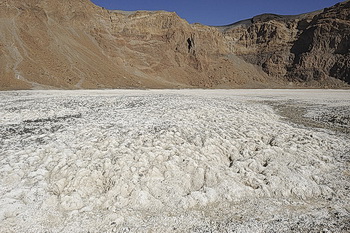Naturally occurring in a number of different colors from pure white, yellow, or even grey, Natron is a mineral that is popular for a variety of reasons. Used extensively by the Egyptians for the mummification process, Natron is commonly found in a number of African countries including Egypt, Chad, and Tanzania which is home to a soda lake, Lake Natron, which gets its name from the mineral.
A mixture of sodium bicarbonate and sodium carbonate decahydrate, Natron is generally powdery or vitreous, and extremely brittle. One of the major reasons why Natron is so popular is because of its commercial use in the production of soda ash, a water-soluble sodium salt with a variety of benefits and usages.
Interested in learning more about this incredible mineral? Read on to find out everything you need to know about Natron, its chemical composition, and the various reasons why it has been such a popular mineral throughout history.
Appearance
As mentioned above, Natron is naturally found in a number of colors from white to grey and even yellow. What’s important to note, however, is that Natron is white in its purest form, whereas the grey and yellow colors come from impurities. In ancient Egypt, the Natron mineral was also used to produce a unique color known as Egyptian blue.
While the mineral generally has a vitreous or powdery appearance, it’s interesting for many that it often appears to be completely colorless when seen against transmitted light. There are, however, a number of different factors that come into play which are responsible for making Natron appear as transparent or translucent.
Physical Properties
 Like a number of other minerals, Natron is a brittle mineral which follows the monoclinic crystal system. Extremely soluble in water, Natron is quick to dehydrate when in contact with air and forms thermonatrite. Additionally, Natron is known for conchoidal fractures and produces tiny fragments.
Like a number of other minerals, Natron is a brittle mineral which follows the monoclinic crystal system. Extremely soluble in water, Natron is quick to dehydrate when in contact with air and forms thermonatrite. Additionally, Natron is known for conchoidal fractures and produces tiny fragments.
A crystal matrix characterized by transpiro-evaporation and matrices of crust-like aggregates are also features that make Natron an interesting mineral that is unique in multiple ways.
Here are some other properties that can help you understand Natron and what the mineral is really all about:
Gemological Properties of Natron
Color: Pure white, yellow, grey
Crystal system: monoclinic
Hardness on Mohs scale: 1 – talc
Luster: Vitreous
Cleavage: Distinct
Luminescence: Phosphorescent
Fracture: Conchoidal
Origins
As mentioned earlier on, Natron was extremely popular in Ancient Egypt owing to its use in the mummification process. However, while Natron has been commonly found in that region for centuries, there are a number of other places where Natron naturally exists.
In addition to Lake Natron which gets its name owing to the abundance of the mineral, Natron is also naturally found in Austria, Italy, Russia, Australia, Canada, the United States, and Hungary.
Chemistry of Constituent Compounds
The Natron mineral comprises two primary constituent compounds, namely sodium bicarbonate and sodium carbonate decahydrate. Sodium carbonate decahydrate follows the monoclinic crystal system which is responsible for it to form crusts. In fact, the monoclinic crystal system is also held responsible for the efflorescence formation of sodium carbonate decahydrate.
Sodium carbonate decahydrate is also known for losing water when in contact with air – a characteristic that it shares with Natron. The specific gravity of the compound is measured to be between 1.42 and 1.47, and it is known to lose crystal water during decrystallization and recrystallization in the form of a salt solution that is generally clear and colorless.
Ways in Which Natron Can Be Used
The production of soda ash is one of the most popular reasons for which Natron is still commercially used. Offering a variety of benefits, soda ash is generally produced either by Natron, or by calicination of sodium carbonate monohydrate, sodium bicarbonate, or Trona, a mineral with similar properties to Natron.
While the production of soda ash is one of the more recent usages of Natron, the mineral is known to have added immense value in a multitude of other ways in the past. Not only was the mineral used extensively for the production of a unique and distinct color that goes by the name “Egyptian blue,” but the mineral was also an extremely popular part of the ceramic manufacturing process. Used alongside sand and lime, Natron would help the Romans and others produce glass and ceramics on a large scale. Owing to its incredibly diverse properties, the mineral was also used as an effective method for soldering various precious metals together in the past.
Even though the industrial usages of the mineral are interesting enough, what surprises quite a number of people is the fact that Natron was also used extensively in health and hygiene. The mineral was not only used for the production of soaps and as a mouthwash, but it was also used in antiseptics and even as a bleaching agent!
Thanks to its dehydrating properties, Natron was also used extensively in the mummification process in ancient Egypt to ensure that all moisture was removed from the body for effective mummification. Additionally, since Natron can increase alkalinity, a hostile environment for bacteria was created by treating bodies of kings and royals with the mineral to ensure that the body does not rot. What’s more, a mixture of Natron and castor oil was often used by artists to prevent staining.
Even though Natron was popular throughout history for its immense usages and unique chemical and physical properties, the mineral is no longer used as commonly. With that said, the most popular alternative of Natron in industrial processes today is soda ash, which is a derivative of the mineral.

